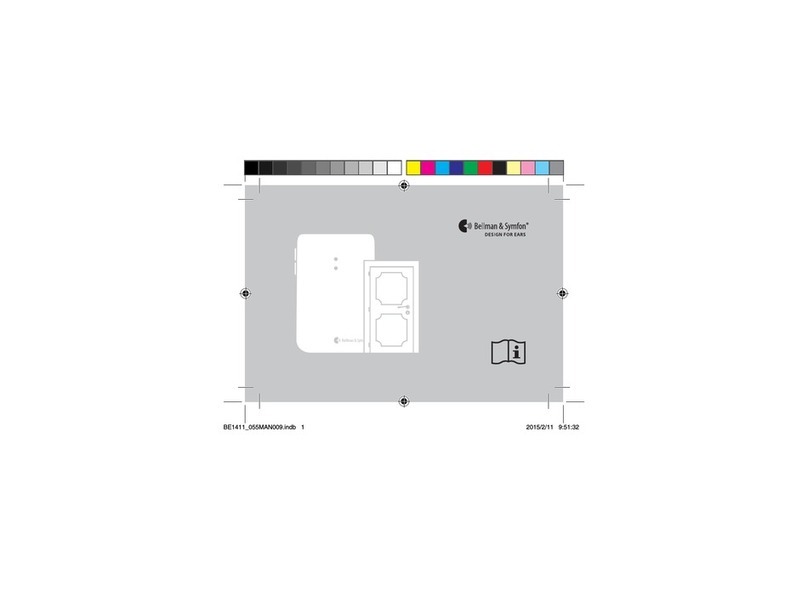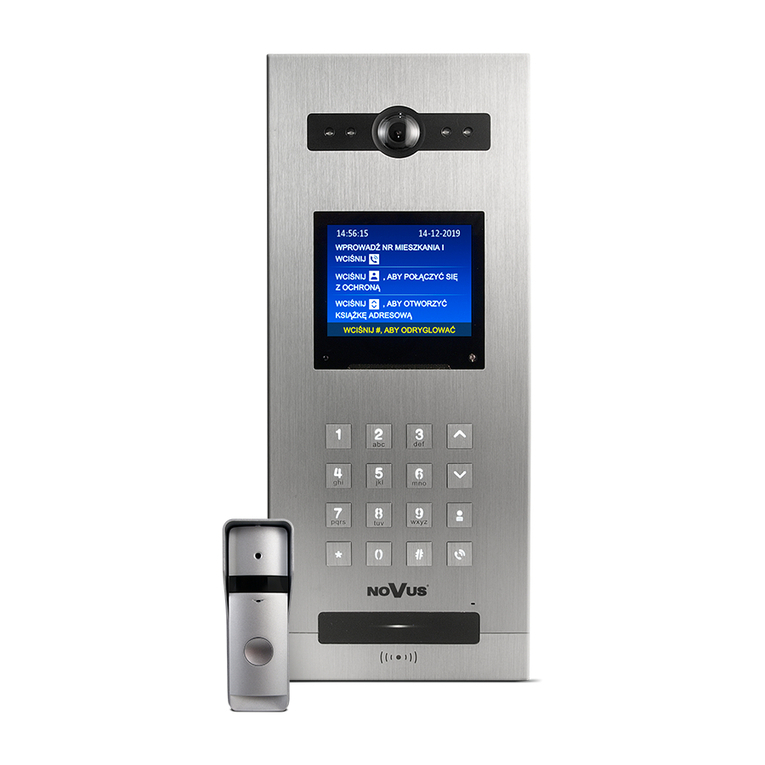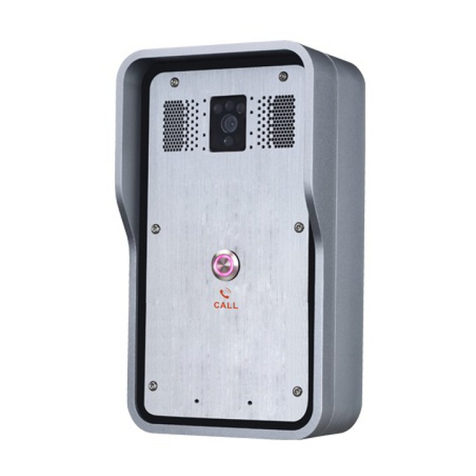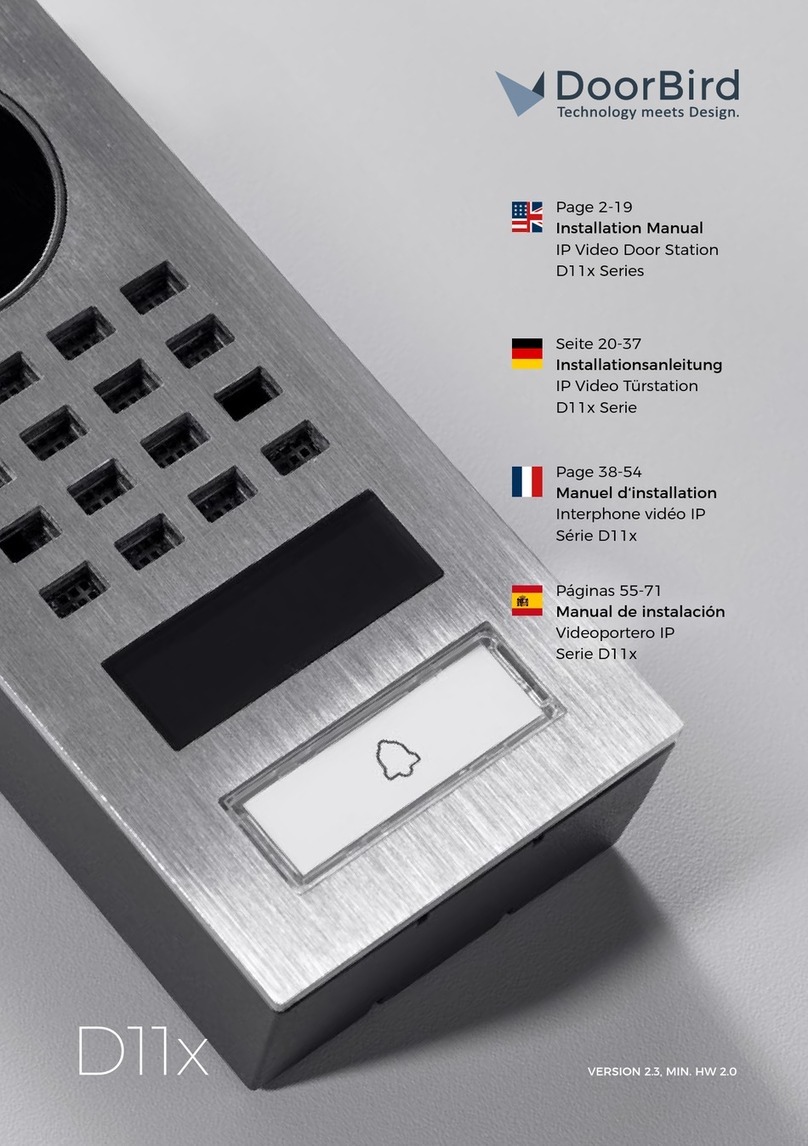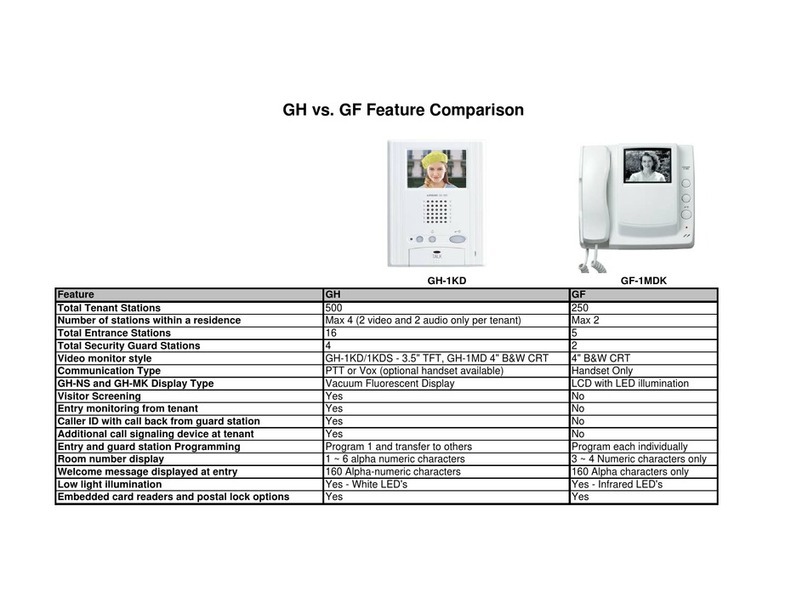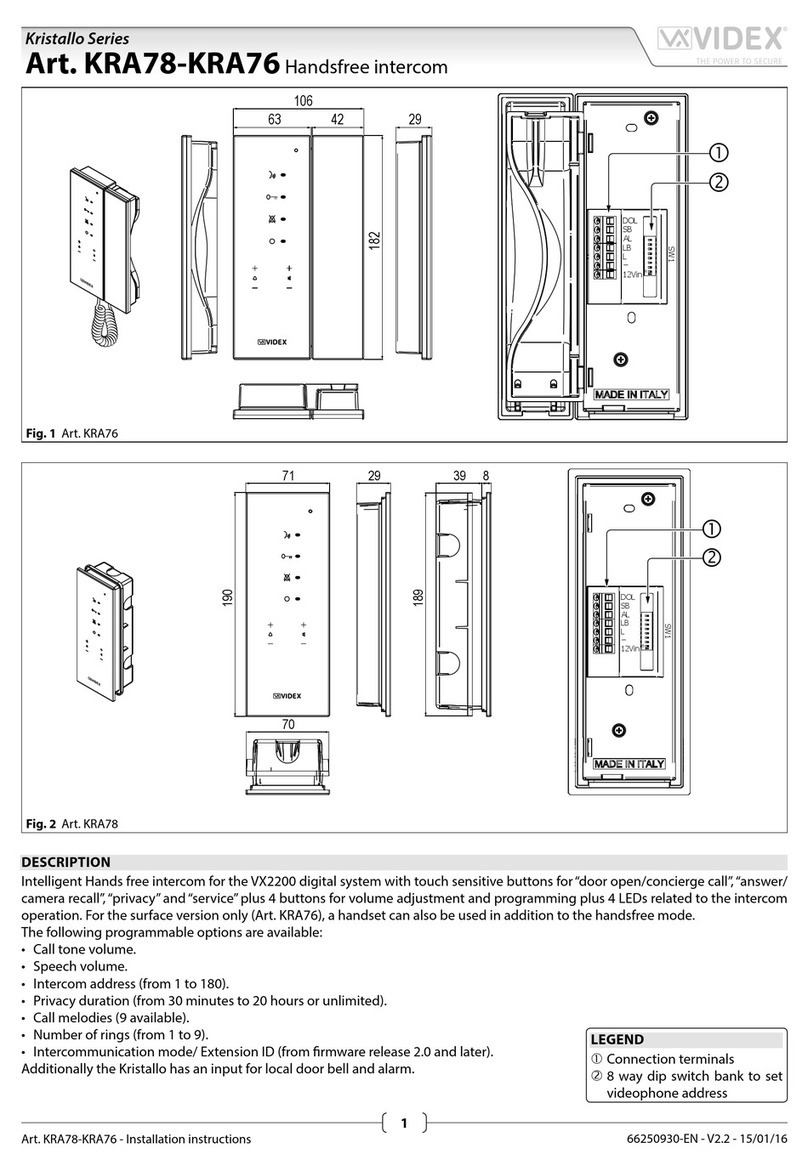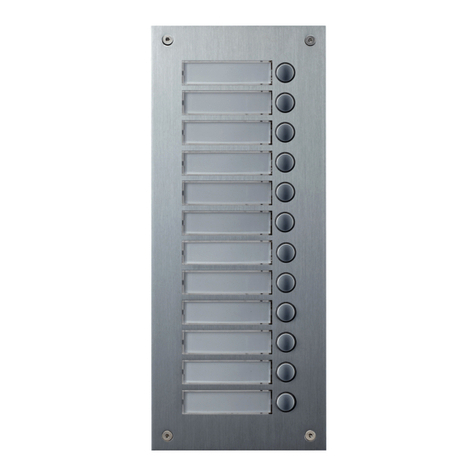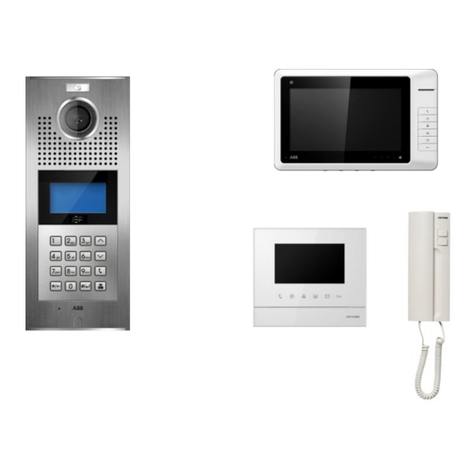Bellman & Symfon BE1411 Assembly instructions

BE1411
Buttons and connections
Visit door transmitter
Test / program buttons
Ext. trig. input
3.5 mm ext. mic. input BE9199 / BE9200
External microphone
Internal microphoneLED lights
Doorbell push button
In the box
BE1411 Visit door transmitter
2
¯1.5 V AA (LR6)
lithium or alkaline batteries
Velcro for wall mounting
Screw and wall plug
Power and battery
Battery power
2¯1.5 V AA lithium or alkaline
type batteries
Power consumption
Active < 70 mA
Idle position < 15 μA
Operation time
Alkaline batteries ~ 5 years
Lithium batteries ~ 10 years
Environment
For indoor use only
Operating temperature
0° to 35° C, 59° to 95° F
Relative humidity
15% to 90%, non-condensing
Frequency and coverage
Frequency: 314.91 MHz, 433.92 MHz
or 868.30 MHz, depending on region
Coverage: 50 - 250 m, 55 - 273 yd.
depending on the radio frequency
and the building’s characteristics
Accessories
The following accessories are available:
BE9199 External microphone 2.5 m
BE9200 External microphone 0.75 m
Dimensions and weight
Height: 100 mm, 4.0"
Width: 65 mm, 2.6"
Depth: 27 mm, 1.1"
Weight: 120 g, 4.2 oz. incl. batteries
Activation
The test buttons and the int. mic.
The electromagnetic detector
The external microphone accessory
The existing doorbell connected to
the external trigger input
Inputs
3.5 mm external microphone input
External trigger input
Technical specications

Installation – single sound source
Using the transmitter’s internal microphone
1Pull the battery tab to start the transmitter.
Clean the wall with the wet wipe and remove the protective lm from the Velcro.
2Mount the door transmitter to the left of the doorbell’s sound source, as close as possible.
You can also use the supplied screw and plug.
1 2
Max 3 cm, 1.2"
Sound source
Alternative installation – single sound source
Using the external microphone accessory
1Connect the external microphone (sold separately) to the transmitter.
Remove the protective lm and attach it to the intercom’s speaker.
2Pull the battery tab to start the transmitter. Remove the protective lm from the Velcro and mount the transmitter on the wall.
3Within 2 min, press the lower button 10 times to turn o the internal microphone. The LEDs will blink 3 times in red to conrm.
Note: If you exceed 2 minutes, you need to restart the transmitter by removing the batteries and putting them back in again.
Turning the internal microphone back on
Restart the transmitter by removing the batteries and putting them back in. Within 2 minutes, press the lower button
10 times to turn the internal microphone back on. The LEDs will blink 3 times in green to conrm.
Ext. mic.
(sold separately)
1 2 3
°10
Visit door transmitter

Visit door transmitter
Installation – intercom and electronic doorbell
1Remove the protective lm from the external microphone (sold separately) and attach it to the intercom’s speaker.
Connect it to the door transmitter.
2Pull the battery tab to start the transmitter.
Clean the wall with the wet wipe and remove the protective lm from the Velcro.
3Mount the door transmitter to the left of the doorbell’s sound source, as close as possible.
Note: The intercom and doorbell must be at least 25 cm, 10" apart to avoid sound interference.
Installation – intercom and mechanical doorbell
If you have an intercom and a mechanical doorbell, you may need two door transmitters, i.e. one for each sound source.
1Pull the battery tab to start each door transmitter.
Clean the wall surfaces with the wet wipe and remove the protective lms from the Velcros.
2Mount one of the door transmitters to the left of the doorbell and the other to the left of the intercom’s speaker, as close
to the sound sources as possible.
2
Ext. mic.
(sold separately)
Electronic
doorbell
Max 3 cm, 1.2"
3
1
Max 3 cm, 1.2" Max 3 cm, 1.2"
1 2

Using electromagnetic detection
The door transmitter can be set to detect electromagnetic elds emitted by electromechanical doorbells.
Here is how it’s done:
Activating electromagnetic detection: Move the 4th signal-switch to the up (on position).
Deactivating electromagnetic detection: Move the 4th signal-switch to the down (o position).
Ext. trig
Ext. trig
Installation – hardwiring your doorbell
1Pull the battery tab to start the transmitter.
Within 2 min, press the lower button 10 times to turn o the internal microphone. The LEDs will blink 3 times to conrm.
2Remove the front cover to access the screw terminal. There are 3 connection points:
Use 1 and 2to connect an active switch, like a relay with current (2–30VDC, polarity independent
or 2–24VAC, 5 - 150Hz).
Use 2and 3to connect a passive switch, like a push button.
3Put the front cover back, remove the protective lm from the Velcro and mount the door transmitter on the wall.
123
°10
2 31
Visit door transmitter
On

Visit door transmitter
Using the doorbell or intercom
1 Press the button on the doorbell or intercom.
The LED on the transmitter lights up in green to show
that the sound is detected.
2 The green Visit LED on the receiver lights up to show
that the radio signal was received. In addition, it starts to
sound, ash or vibrate depending on the receiver.
Note: If you have changed the signal pattern, it will react
in accordance with the table on the following spread.
Testing the connection
Using the test button
1 Press both test buttons simultaneously on the door
transmitter. The top LED lights up in green to show that
a radio signal is being transmitted.
2 The green Visit LED on the receiver lights up to show
that the signal was received. In addition, it starts to
sound, ash or vibrate depending on the receiver.
Note: If you have changed the signal pattern, it will react
in accordance with the table on the following spread.
1 2 1 2
1 2 3
OK
Try again
Optimizing the doorbell detection
The next step is to teach the transmitter to recognize your doorbell.
1Press and hold button 1 until the top LED start to blink. Release it to start the recording.
2For door buzzers (with continous sound): Press and hold the doorbell for at least 8 seconds.
For door chimes (with a "ding-dong" sound): Press the doorbell at least 8 times.
3Press button 1 on the transmitter to stop the recording. If the LED lights up in red, you need to repeat steps 1 and 2.
If you have an intercom, use button 2 and follow the steps above to record its sound.
Note: To delete all recorded sounds, press and hold button 1 and 2 simultaneously for 5 s. All radio key settings and
signal settings are kept intact.

Default signal pattern
When the door transmitter is activated, the following happens:
1The LED on the transmitter lights up in green to show that it’s signalling the receiver.
2The Visit LED on the receiver lights up in green and it starts to sound, ash or vibrate with a certain pace, called signal
pattern. The transmitter and the connected accessories determine the signal pattern. The default is as follows:
Transmitter Receiver signal pattern
Source LED LED Sound Vibration Flash
Internal microphone Green, top Green light 1¯door chime, low Slow Yes
External microphone Green, bottom Green blinks 2¯door chime, high Slow Yes
Connected doorbell Green, top 3¯green blinks 1¯door chime, high Slow Yes
Changing the signal pattern
The transmitter controls the signal pattern. Open the transmitter front cover and move the
signal switches according to the table below to change it:
Transmitter Receiver signal pattern
Switch Source LED Sound Vibration Flash
Int. mic. / learned signal 1 / test Green light 1¯door chime, low Slow Yes
Ext. mic. / learned signal 2 Green blink 2¯door chime, high Slow Yes
Connected doorbell 3¯green blinks 1¯door chime, high Slow Yes
Int. mic. / learned signal 1 / test 2¯green blinks 2¯door chime low Slow Yes
Ext. mic. / learned signal 2 3¯green blinks 1¯door chime, high Slow Yes
Connected doorbell Green blinks 2¯door chime, high Slow Yes
Int. mic. / learned signal 1 / test 3¯green blinks 1¯door chime, high Slow Yes
Ext. mic. / learned signal 2 2¯green blinks 2¯door chime, low Slow Yes
Connected doorbell 3¯orange blinks Baby melody Fast Yes
Int. mic. / learned signal 1 / test Green blinks 2¯door chime, high Slow Yes
Ext. mic. / learned signal 2 Green light 1¯door chime, low Slow Yes
Connected doorbell Orange blinks Baby melody Fast Yes
Int. mic. / learned signal 1 / test Green light 1¯door chime, low Slow Yes
Ext. mic. / learned signal 2 3¯green blinks 1¯door chime, high Slow Yes
Connected doorbell 2¯green blinks 2¯door chime, low Slow Yes
Int. mic. / learned signal 1 / test Green light 1¯door chime low Slow Yes
Ext. mic. / learned signal 2 Green blinks 2¯door chime, high Slow Yes
Connected doorbell Yellow blinks 2¯ring signal, high Medium Yes
Int. mic. / learned signal 1 / test 3¯green blinks 1¯door chime, high Slow Yes
Ext. mic. / learned signal 2 Green light 1¯door chime, low Slow Yes
Connected doorbell Red + orange light Emergency siren Long Yes
Int. mic. / learned signal 1 / test Green blinks 2¯door chime, high Slow Yes
Ext. mic. / learned signal 2 2¯green blinks 2¯door chime, low Slow Yes
Connected doorbell Red blinks Fire horn Long Yes
On
O
Visit door transmitter

If Try this
The LEDs blink in orange every minute Replace the batteries. Only use 1.5 V AA (LR6) lithium or alkaline batteries.
The transmitter LEDs blink in orange
every second
There are other competing sound sources around the door transmitter. Switch
them o or turn them down.
Disconnect the external microphone accessory to make sure it is not faulty.
The transmitter LED lights up when I
press the doorbell or intercom – but
the receiver is not activated
Check the the transmitter batteries and the receiver batteries and connections.
Move the receiver closer to the transmitter to make sure it’s within radio range.
Check that the door transmitter and the receiver are set to the same radio key.
For more information, see Changing the radio key.
The transmitter LED doesn’t light up
when I ring the doorbell or intercom
Ring the doorbell while moving the transmitter closer and further away from
the sound source. The ideal distance is less than 3 cm.
Program the transmitter to recognize the doorbell sound. See Programming.
If the signal varies a lot in strength or tone, change to electromagnetic detection.
If the door transmitter is still not activated, press and hold button 1 and 2
simultaneously for 5 s to clear the recorded sounds and repeat the steps above.
The receiver is activated for no
apparent reason
There is probably another Visit system installed nearby that triggers your
system. Change the radio key on all units, see Changing the radio key.
Changing the radio key
If your Visit system is activated for no reason, there is probably a nearby system that triggers yours. In order to avoid radio
interference, you need to change the radio key on all units. The radio key switches are located under the transmitter cover.
Here is how you change the radio key:
1Open the transmitter front cover and move any radio key switch to the up (on position) to
change the radio key. By default, all radio key switches are positioned down (o).
2Press and hold the test/function button on the receiver until the green and yellow Visit LEDs
blink alternately. Release the button.
3Press both test buttons simultaneously on the transmitter within 30 s to send the new radio key.
4All Visit LEDs on the receiver blink 5 times to show that the radio key has been changed. It then returns to normal mode.
Note: All Visit units must be set to the same radio key in order to operate as a group.
°5
Troubleshooting
1 2 3 4
On
O
Visit door transmitter
Other manuals for BE1411
10
Table of contents
Other Bellman & Symfon Intercom System manuals
Popular Intercom System manuals by other brands
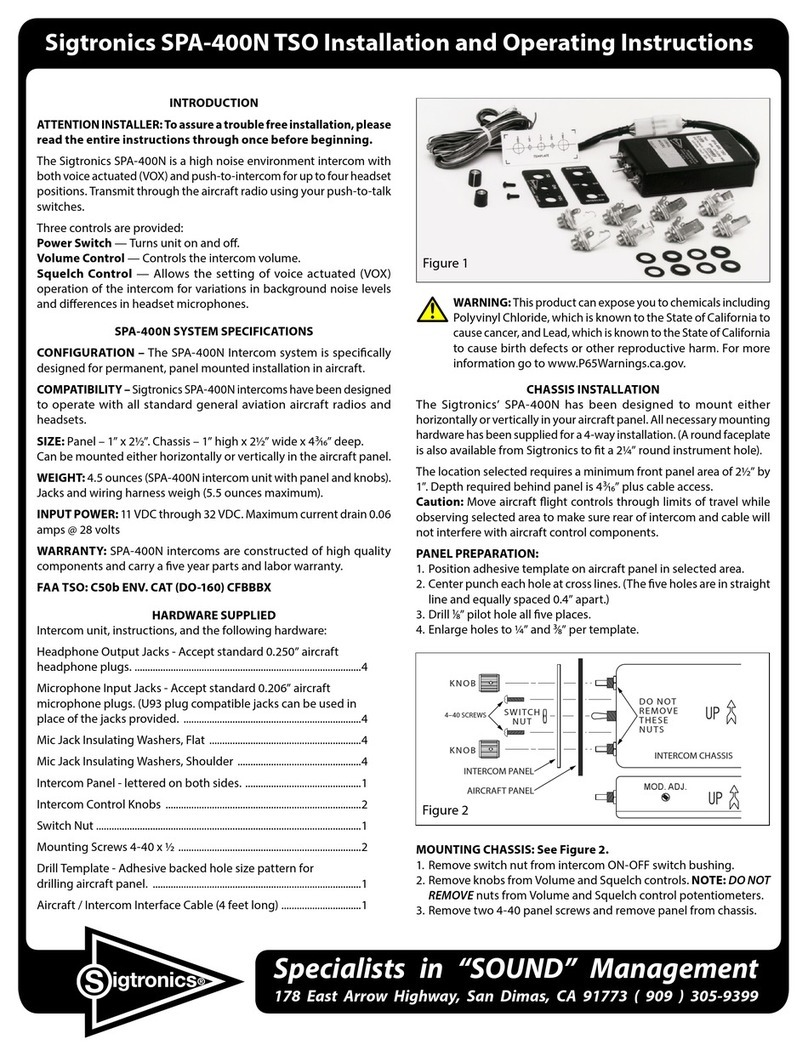
Sigtronics
Sigtronics SPA-400N Installation and operating instructions

KIVOS
KIVOS KDB702 user manual

Comelit
Comelit Venice 6814W user manual
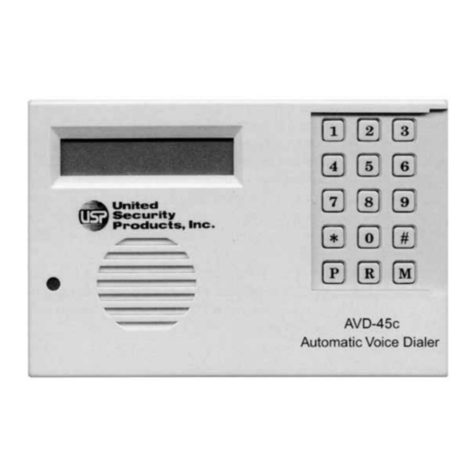
United Security Products
United Security Products AVD-45c Installation and instruction manual
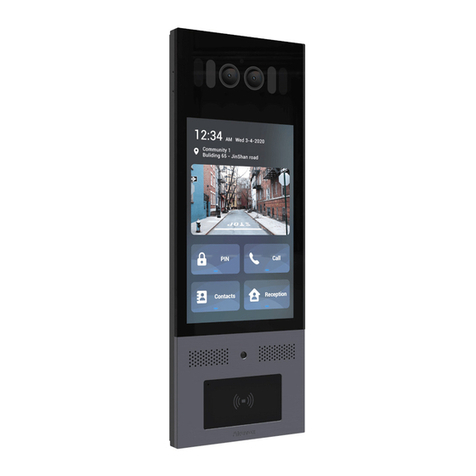
Akuvox
Akuvox X915 Series quick guide
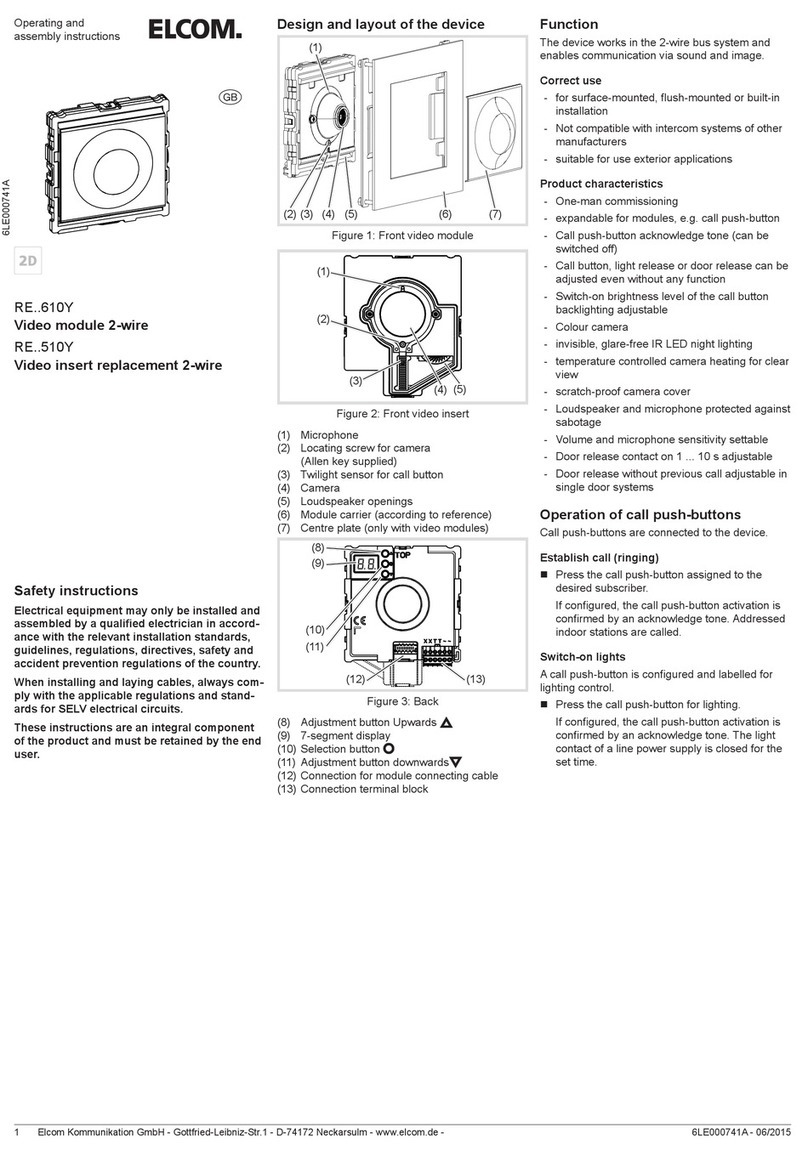
ELCOM
ELCOM RE 610Y Series Customer's operating and assembly instructions
